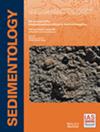加拿大艾伯塔省麦克默里组流潮转换点坝的沉积学和技术变化
IF 2.8
2区 地球科学
Q1 GEOLOGY
引用次数: 0
摘要
对流潮转换点坝的沉积学和技术描述非常罕见,复杂的物理化学过程使得非常详细但简明的相描述具有挑战性。本文定义了中相,用于描述和解释加拿大阿尔伯塔省下白垩统McMurray组的三个古平移点坝。根据沉积学和技术特征,确定了23个中相。这些中相构成了三种沉积相的层和层组的组成单元。相1反映了河道底部的沙丘迁移,可分为相2和相3的倾斜异石器层状。相2发生在平移点坝的中心和向海部分,记录了河流流量减少时期以潮汐为主的砂和泥砂沉积。这些地层中的技术层和生物扰动强度反映了持续但可变的微咸水条件、波动的沉积速率和泥浆沉积。泥床是由高悬浮沉积物浓度的水流形成的。潮汐形成的泥层具有典型的生物扰动,具有微量化石组,表明沉积速率缓慢,咸淡水条件。高架河道排水过程中沉积的泥浆在河床脱水后挖洞。相3发生在平移点坝的陆向顶端,以富砂和富泥沙丘沉积为标志,软沉积变形丰富,表明水流速度和沉积速率升高。由于底物不稳定,生物扰动是罕见和零星分布的。这些相的分布反映了河流和潮汐相互作用的时间变化所引起的垂直和横向的水动力变化,这是由它们的中相记录的。详细的相分析有力地表明,三个McMurray组转换点坝的沉积发生在河流-潮汐通道体系浊度最大带附近。本文章由计算机程序翻译,如有差异,请以英文原文为准。
Sedimentological and ichnological variations in fluvio-tidal translating point bars, McMurray Formation, Alberta, Canada
Sedimentological and ichnological descriptions of fluvio-tidal translating point bars are rare, and complex physico-chemical processes make highly detailed but concise facies descriptions challenging. Herein, mesofacies are defined to describe and interpret three ancient translating point bars from the Lower Cretaceous McMurray Formation, Alberta, Canada. Twenty-three mesofacies are defined, based on their recurring sedimentological and ichnological characteristics. These mesofacies form the building blocks of beds and bedsets that make up three depositional facies. Facies 1 reflects sand dune migration at the channel base, which grades into inclined heterolithic stratification of facies 2 and 3. Facies 2 occurs in the centre and seaward portions of the translating point bars and records tide-dominated deposition of sand and muddy sand during periods of reduced river discharge. Ichnological suites and bioturbation intensities in these beds reflect persistent but variable brackish-water conditions, fluctuating deposition rates and the deposition of mud. Mud beds are derived from flows with high suspended-sediment concentrations. Tidally derived mud beds are typically bioturbated with trace fossil suites indicative of slow deposition rates and brackish-water conditions. Mud deposited during elevated river discharge is burrowed after the dewatering of the bed. Facies 3 occurs at the landward apex of the translating point bar and is marked by sand-rich and mud-rich dune deposits with abundant soft-sediment deformation, indicative of elevated flow velocities and deposition rates. Bioturbation is rare and sporadically distributed owing to unstable substrates. The distribution of the facies reflect the hydrodynamic variations that occurred vertically and laterally across the bar in response to temporal variations in fluvial and tidal flow interaction, as recorded by their mesofacies. The detailed facies analysis strongly suggest that deposition of the three McMurray Formation translating point bars occurred in proximity to the turbidity maximum zone of a fluvio-tidal channel system.
求助全文
通过发布文献求助,成功后即可免费获取论文全文。
去求助
来源期刊

Sedimentology
地学-地质学
CiteScore
8.20
自引率
11.40%
发文量
94
审稿时长
6-12 weeks
期刊介绍:
The international leader in its field, Sedimentology publishes ground-breaking research from across the spectrum of sedimentology, sedimentary geology and sedimentary geochemistry.
Areas covered include: experimental and theoretical grain transport; sediment fluxes; modern and ancient sedimentary environments; sequence stratigraphy sediment-organism interaction; palaeosoils; diagenesis; stable isotope geochemistry; environmental sedimentology
 求助内容:
求助内容: 应助结果提醒方式:
应助结果提醒方式:


